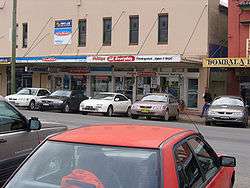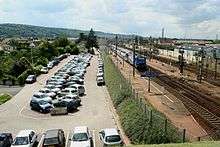Parking space

A parking space is a location that is designated for parking, either paved or unpaved.
Parking spaces can be in a parking garage, in a parking lot or on a city street. It is usually a space delineated by road surface markings. The automobile fits inside the space, either by parallel parking, perpendicular parking or angled parking.
Depending on the location of the parking space, there can be regulations regarding the time allowed to park and a fee paid to use the parking space. When the demand for spaces outstrips supply vehicles may overspill park onto the sidewalk, grass verges and other places which were not designed for the purpose.[1]
Patterns
For most motorised vehicles, there are three commonly used arrangements of parking spaces — parallel parking, perpendicular parking, and angle parking. These are self-park configurations where the vehicle driver is able to access the parking independently.
Parallel parking
With parallel parking of cars, these are arranged in a line, with the front bumper of one car facing the back bumper of an adjacent one. This is done parallel to a curb, when one is provided. Parallel parking is the most common mode of streetside parking for cars. It may also be used in parking lots and parking structures, but usually only to supplement parking spaces that use the other modes.
Perpendicular parking

With perpendicular parking, also known as bay parking, cars are parked side to side, perpendicular to an aisle, curb, or wall. This type of car parking fits more cars per length of road (or curb) than parallel parking, and is therefore commonly used in car parking lots and car parking structures.
Often, in car parking lots using perpendicular parking, two rows of parking spaces may be arranged front to front, with aisles in between. If no other cars are blocking, a driver may perform a "pullthrough" by driving through one parking space into the connecting space to avoid having to reverse out of a parking space upon their return.
Sometimes, a single row of perpendicular car parking spaces is marked in the center of a street. This arrangement eliminates reversing from the manoeuvre; cars are required to drive in forwards and drive out forwards.
Angle parking/echelon parking

Angle parking, known as echelon parking in Britain, is similar to perpendicular parking for these vehicles, except that cars are arranged at an angle to the aisle (an acute angle with the direction of approach). The gentler turn allows easier and quicker parking, narrower aisles, and thus higher density than perpendicular parking. While in theory the aisles are one-way, in practice they are typically wide enough to allow two cars to pass slowly when drivers go down the aisles the wrong way.
Angle parking is very common in car parking lots. It may also be used in streetside car parking in the U.S. when there is more width available for car parking than would be needed for parallel parking of cars, as it creates a larger number of parking spaces. Some cities have utilized angled parking on-street (as compared to off-street parking facilities). This has been done mostly in residential, retail and mixed use areas where additional parking compared to parallel parking is desired and traffic volumes are lower. Most angled parking is design in a head-in configuration while a few cities (Seattle, Portland, Baltimore, and Indianapolis are examples) have some back-in angled parking (typically on hills or low traffic volume streets).
Angle parking is considered dangerous by cycling organisations, especially in the head-in configuration, but unwelcome in either form. When comparing to parallel parking:
- There is a significant risk to cyclists from vehicles reversing out, as approaching bicycles are in the blind spot of the reversing and turning vehicles.[2]
- Longer vehicles project further into the road; this can inconvenience/endanger other road users,
- The "surplus" road space which enables angle parking could also be used for bicycle lanes.
Hence organisations such as the Cyclists Touring Club are usually opposed to all proposed echelon parking schemes, though there are some alternatives, such as "back in" angle parking (slanted the "wrong" way, with the driver reversing into the space, rather than reversing out), which can overcome many of the issues of safety.

Other parking methods
Besides these basic modes of motor vehicle parking, there are instances where a more ad hoc approach to arranging motor vehicles is appropriate. For example, in parts of some large cities, such as Chicago, where land is expensive and therefore parking space is at a premium, there are parking lots for motor vehicles where the driver leaves the keys to the vehicle with an attendant who arranges vehicles so as to maximize the number of vehicles that can be parked in the lot. Vehicles may be packed up to five vehicles deep in combinations of perpendicular and/or parallel parking with limited circulation aisles for the parking attendant. Such arrangements are known as attendant parking. When the lot or facility is provided to serve the customers of a business, it is considered valet parking.
Inner city parking lots are often temporary, the operators renting land which is vacant pending the construction of a new office building. Some inner city lots are equipped with individual lifts, allowing cars to be stored above each other.
Another ad hoc arrangement is tandem parking. This is sometimes done with residential motor vehicle parking where two motor vehicles park nose-to-end in tandem. The first motor vehicle does not have independent access, and the second motor vehicle must move to provide access. As with attendant parking, the purpose is to maximize the number of motor vehicles that can park in a limited space.
Marks and space size
In parking lots, parking is allowed only where marked.[3]
In North America, the width of angled and perpendicular parking spaces usually ranges from 2.3 to 2.75 metres (7.5–9.0 ft). For example, normal parking spaces in the city of Dallas, Texas are 8.5 feet (2.6 m) wide, while compact spaces are 7.5 feet (2.3 m) wide.[4]
Because the boundary between parking space and driving area is not always well-defined, the length of a parking space is more difficult to establish. However, most angled and perpendicular spaces are considered to be between 3.2 and 5.5 metres (10–18 ft) in length. Though, in the United States, a parking space 10 feet (3.0 m) deep is uncommon and most parking spaces will be within 16 to 20 feet (4.9–6.1 m), with 19 feet (5.8 m) feet deep being the standard DOT recommended depth for standard perpendicular parking.
Parallel parking spaces are typically cited as being approximately 2.76 metres (9.1 ft) wide by 6.1 metres (20 ft) long.
During construction, the specific dimensions of a parking space are decided by a variety of factors. A high cost of land will encourage smaller dimensions and the introduction of compact spaces.[5] Many garages and parking lots have spaces designated for a Compact car only. These spaces are narrower than traditional spaces, thus allowing more cars to park.[6]


According to French standard “Norme NF P 91-100”, minimum width of parking spaces range from 2.20 to 2.30 metres (7.2–7.5 ft) (See fr:Marquage du stationnement en France). Narrow parking spaces such as in Vevey, Switzerland might make opening the door difficult in a larger vehicle.
Larger cars are an issue when the size of the parking spot is fixed. Automobile associations warn of this issue.[7] A Swiss Association regulating parking space wants to consider this issue for 2016.
In the United Kingdom the recommended standard Parking bay size is 2.4 metres (7.9 ft) wide by 4.8 metres (16 ft) long. Recently there has been some controversy about most UK parking spaces being too small to fit modern cars, which have grown significantly since standards were set decades ago.[8]
Barriers

Parking spaces commonly contain a parking chock (wheel stop), which is used to prevent cars from pulling too far into the space and
- obstructing a neighboring parking space, curb, or sidewalk.
- contacting with and then damaging a building wall.
This barrier is usually made of concrete and will normally be a horizontal bar to stop the tires from moving forward or a vertical bar that may cause damage to the vehicle if contact is made. In a parking garage, the barrier will often be a concrete wall.
Parking spaces for the disabled

Some parking spaces are reserved as handicapped parking, for individuals with disabilities. Handicapped parking spaces are typically marked with the International Symbol of Access, though in practice, the design of the symbol varies widely.[9]
In the United States the Access Board provides guidelines on parking spaces.[10][11]
Women's parking spaces
In some countries, women's parking spaces have been established in more visible spots to reduce the chance of sexual attacks,[12] facilitate parking for women, or to provide spaces that are closer to shopping centers or employment.[13][14]
US curb markings
Curb markings in the United States are prescribed by the Manual of Uniform Traffic Control Devices (MUTCD).[15] Local highway agencies may prescribe special colors for curb markings to supplement standard signs for parking regulation. California has designated an array of colors for curb regulations. A white curb designates passenger pick up or drop off. The green curb is for time limited parking. The yellow curb is for loading, and the blue curb is for disabled persons with proper vehicle identification. The red curb is for emergency vehicles only - fire lanes (no stopping, standing, or parking). In Oregon and Florida, the yellow curb is utilized to indicate no parking. In Georgia either red or yellow can be used to indicate no parking. In Seattle, Washington, alternating red and yellow curb markings indicate a bus stop.
See also
- Parking chair (for snowstorms)
References
- ↑ "Possible kerb-space management solutions". Dartford Borough Council. Retrieved 2009-07-25.
- ↑ UK Department of Transport Cycle Infrastructure Design
- ↑ https://www.hoas.fi/www/hoaswww.nsf/sp3?open&cid=Content2DC29
- ↑ http://www.dentonrc.com/sharedcontent/dws/dn/latestnews/stories/DN-compactpark_26met.ART.State.Edition1.369e7c2.html
- ↑ A Comprehensive Menu of Solutions to Parking Problems Victoria Transport Policy Institute
- ↑ "Houston Parking Lot Line Striping, Parking Lot Maintenance".
- ↑ for instance Niklaus Zürcher, Automobile Club de Suisse, did it in «Der Sonntag». http://www.20min.ch/ro/news/suisse/story/Places-de-parc-trop-petites-pour-grosses-voitures-25814008
- ↑ "UK parking bays too small".
- ↑ www.youcantparkhere.com A gallery of handicapped parking symbols.
- ↑ http://www.access-board.gov/guidelines-and-standards/buildings-and-sites/about-the-ada-standards/background/adaag
- ↑ Revised Draft Guidelines for Accessible Public Right-of-Way and ADA Accessibility Guidelines for Buildings and Facilities (ADAAG)
- ↑ FAQ of the German Federal Anti-Discrimination Agency (archived)
- ↑ Will High-Heel-Friendly Streets Keep Seoul's Women Happy?, Time, 2009
- ↑ Le Monde (fr) article about women's parking spaces in China
- ↑ Manual of Uniform Traffic Control Devices, FHWA, 2009, Section 3B-23.
External links
| Wikimedia Commons has media related to Parking. |